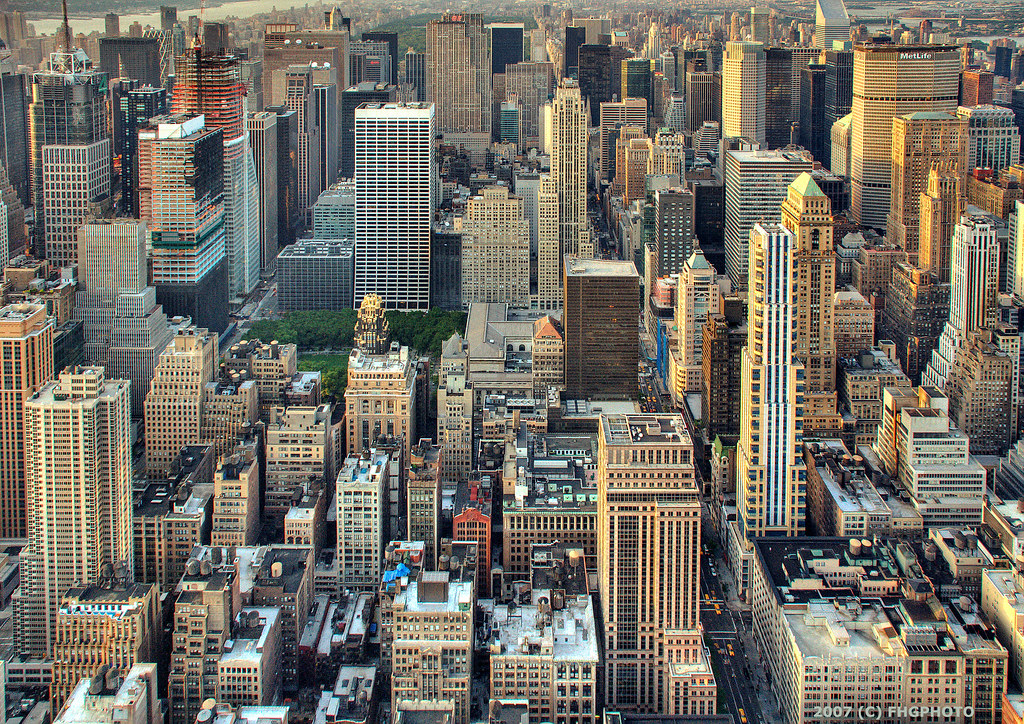In his dialogue with Chris Cuomo in March, Tucker Carlson launched into a characteristic diatribe, railing against modern architecture which is “designed to demoralize you.”[1] Indeed, the “international style,” because it is everywhere, winds up making every place feel like “nowhere in particular,”[2] and people who live and work in such places receive the message that they are replaceable, cogs in a machine, “widgets in a bin awaiting assembly.”[3] Le Corbusier, the father of modern architecture, set out a century ago to do away with the building customs and traditions that had guided cultures past. These timeless ways of building were apparently “no longer of any interest.”[4]
Le Corbusier’s building philosophy is taught in nearly every architecture program on the planet, even though a very large portion of the population seems to agree with Carlson that it has failed. Polls consistently reveal that around 80% of Americans—regardless of age, sex, race, or political affiliation—prefer traditional buildings to modern ones. Here we actually have something that every major identity group agrees on, yet what continues to be built is clearly not representative of what the majority wants.
One reason for this is popular ignorance—if asked, people tend to assume that traditional ways of building are too expensive, or not properly energy-efficient, or just not feasible in a world of mass production. However, building in a “traditional” way is largely a matter of proportion, balance, and scale, and does not need to involve gold gilding or grandiose Corinthian columns. Thus, traditional buildings can be just as mass-producible and energy-efficient as all the oddly-shaped glass, concrete and steel monstrosities pervading the urban landscape today, most of which get built without public approval. In Scandinavia this is starting to change; a growing movement (Arkitekturupprororet—“architectural uprising”) is pushing back against urban uglification, and local politicians have actually had to start taking notice and give architecture a place on their policy agendas. There is no good reason why urban planning and building shouldn’t be a properly democratic process, for “the architecture of the city and public space is a matter of common concern to the same degree as laws and language.”[1]
A second reason is ideology—architects are no longer interested in ideals like beauty and harmony, preferring novelty and self-expression instead. Ideology is also why they focus more on making buildings “green” than on making buildings that last, which means that no matter how many planter boxes they put on balconies the modern style is ultimately environmentally unsustainable. A truly sustainable building is a beautiful building, since beautiful buildings are the ones that people actually want to preserve, while ugly ones get torn down and rebuilt. Tradition is a dirty word in the industry today, and one is hard-pressed to even find a school that still teaches the traditional building arts. When I became interested in pursuing architecture as a career here in Europe, the closest accredited classical architecture program I could find was about 4,000 miles away on another continent.
A third reason is mental illness. Mental disorder gave us modern architecture, says Ann Sussman, a researcher interested in the way buildings influence brains.[5] Sussman was referring specifically to autism (Le Corbusier) and PTSD (Walter Gropius and Ludwig Mies van der Rohe). Mental disorder also helps explain why modernist architecture continues to be built, if we allow that scientific materialism is a kind of disordered thinking. A dogmatic belief in the exclusively bottom-up emergence of all natural complexity, from molecules to minds, easily leads to various other pathologies.
In the early twentieth century Rudolf Steiner expressed serious concern about teaching children arithmetic using an abacus and other standard methods of addition,[6] on the grounds that it leads them to understand wholes as no more than the sums of their parts. This way of seeing the world is now ubiquitous, and so it is not surprising that many trendy modern apartment complexes resemble something a five-year-old might construct while playing Minecraft.
The materialist worldview is waning, and modernist architecture is a failed experiment on numerous fronts. Overcoming both will be a joint venture, because what we produce and surround ourselves with inevitably changes how we think and what we believe—“we shape our buildings and our buildings shape us,” as Churchill put it.
Once upon a time, a boy was walking home from school and happened upon three bricklayers. “What are you doing?” the boy asked the first bricklayer. “I’m laying bricks,” he replied. “And what are you doing?” the boy asked the second. “I’m making a wall,” he responded. “What about you?” the boy inquired of the third. “I’m building a cathedral,” he said. All three bricklayers were doing the same thing, but the work of the third flowed from his understanding of the whole to which he contributed.
If indeed a culture enshrines its soul through the things it makes, then we are in deep trouble, for our collective soul is clearly very sick. This societal dis-ease is at least partially to do with how we attend to the world. As Iain McGilchrist continues to argue, the modern world is left-hemisphere-dominant, and this results in a way of seeing whose “principal concern is utility, [which] is interested in . . . the world as a resource to be used.”[7]
Contemporary neuropsychology and evolutionary biology make it quite clear that humans thrive in certain environments and suffer in others. For example, humans naturally prefer curves to straight lines—“curves elicit feelings of happiness and elation, while jagged and sharp forms tend to connect to feelings of pain and sadness.”[8] Not only do humans prefer curves, we also have an innate aversion to horizontal and parallel lines as well—research finds that “as more and more stripes in building facades appear decade by decade, the buildings become less and less comfortable to look at.”[9] Various technologies like eye-tracking, facial expression analysis software, brain wave measurement, and galvanic skin responders which track the activity of sweat glands[10] have confirmed that modern aesthetics induce stress, requiring more oxygen uptake for visual image processing in the brain. It is therefore safe to conclude that, in addition to being preferred by the majority of the population for aesthetic reasons, traditional buildings and cities are healthier, friendlier, and more humane as well. Anyone wishing to argue otherwise has the empirical evidence to deal with, and its results are clear. Humans did not evolve for thousands of years in environments dominated by grids and horizontal stripes. The modern environment is, however, nothing if not rectilinear.
Minimalism is sold in magazines and on social media as “sleek” and “clean” and “crisp,” and so from whole cities down to individual buildings to doors to door handles and everything in between, modernism promotes a synthetic, artificial, sterile environment. (Makers of Ikea furniture and producers generally are no doubt thrilled about this contemporary preference as it makes their mass production process much simpler.) Architectural traditionalism is looked down upon because it is misunderstood as retrograde (when it fact true progress is always birthed out of a living tradition) and because as a society we’ve bought into the myth of perpetual progress where Western civilization is a story of linear ascent from the caves to the stars, and so anything not perceived as progressive is totally anathema.
As embodied creatures embedded in an environment, we experience our environment not merely visually but viscerally. For example, seeing a door handle activates not only optic nerves but also some of the motor neurons that would have fired had it been grasped and twisted. When a person enters a room, there is an immediate subconscious assessment of what James Gibson called affordances, which are what an environment “offers the animal, what it provides or furnishes, either for good or ill.”[11] A pond does not afford stability for a human being, who will walk around it, but it does afford stability for a waterbug which can walk along its surface tension safely. Whether we realize it or not, we are always scanning our environment for things it affords us. The sorts of interiors exemplifying the Scandinavian “simplicity” so in vogue today, characterized by flat featureless surfaces and hard, clean lines, offer relatively few affordances, and consequently offer a less restful and more stressful user experience.
We cannot avoid the psychological influence of the forms and materials around us any more than an aeolian harp can avoid being played by the wind. And it is not only the shapes of buildings and objects that matter, but the presence, warmth, and tactile value of the materials used, along with their contextual relation to other objects and to their natural environment.[13] This is easily forgotten by today’s modernist architects, who busy themselves manipulating abstract forms from behind their computer screens, and may never even set foot on the job site.
We supposedly “believe in science” but the scientific evidence is in and dystopia continues to advance, covering the developed world in synthetic, unnaturally-colored, fluorescently-lit, strangely-proportioned, and inhumanely-scaled artifacts. Disregard for the knowledge we have about humans and humane environments is contributing to a public health crisis. There is no nicer way of saying this. Modern architecture is doing a huge disservice to the planet and to people, and it is being done in the name of aesthetic relativism and other ideologies that don’t stand up to the slightest scrutiny. It is a depraved philosophy and one we are paying for dearly, not only psychologically but financially, ecologically, and socially.
How is it that utility can be considered the most important aspect of a building, yet the way it makes one feel does not factor into the equation? Is a building truly functioning if it makes one depressed to live or work in it? Has an architect truly succeeded if his creation raises the stress levels of the people walking or driving past it? An ugly painting can be replaced, and a tiresome song can be turned off, but the oppressive banality of the modern world is all but inescapable.
Buildings are never neutral. Everything we create is an expression of who we are, which is either elevating or demoralizing to our spirits. While it is true that the vast majority of people do not have architecture as a primary interest, anyone can recognize that “churches that resemble warehouses, palaces of culture that imitate oil refineries or train wrecks, and houses that look like ships”[2] are an impoverishment to society.
Arched doorways, private courtyards, personal craftsmanship, a sense of place, and almost everything else we love about buildings has been taken away by the modernist ethos intent on depriving the public of a choice, as architects are left unchecked to focus more on how their buildings look in magazines than on how the people using them feel. This is unacceptable, for architecture is a matter of concern for society as a whole, and “the public should be its judges, not a small coterie promoting its own agenda.”[3]
What can we do about this? Currently “the creative freedom permitted in contemporary architecture is dictated by trendsetters, power brokers, and influential critics,”[4] but we the people can turn things around. A good place to start is following the example of the various “architecture uprisings” happening now in Europe. Back in 2014, the Swedish architect Eric Norin founded the first Architecture Uprising movement and began posting before-and-after photos of European streets and buildings on a facebook page. Seeing the stark contrast between what used to exist and what had replaced it caused many people to start taking interest. Norin and his friends now have hundreds of thousands of followers on various social media platforms, and they’ve managed to bring the issue into the everyday discussion of common folk in Scandinavia. For now, we must continue to spread the word, and help people see how modernism has failed us. It is time to take wholeness, health and beauty seriously again.
Image via Flickr
[1] https://tuckercarlson.com/the-tucker-carlson-interview-chris-cuomo/.
[2] https://www.amazon.pl/Geography-Nowhere-Declineof-Americas-Landscape/dp/0671888250.
[3] https://tuckercarlson.com/the-tucker-carlson-interview-chris-cuomo/.
[4] Le Corbusier, Towards a New Architecture.
[5] https://commonedge.org/the-mental-disorders-that-gave-us-modern-architecture/.
[6] Rudolf Steiner, The Kingdom of Childhood.
[7] Iain McGilchrist, The Master and His Emissary.
[8] Ann Sussman and Justin B. Hollander, Cognitive Architecture, 181.
[9] Ann Sussman and Justin B. Hollander, Cognitive Architecture, 184.
[10] Ann Sussman and Justin B. Hollander, Cognitive Architecture, 231.
[11] James J. Gibson, The Ecological Approach to Visual Perception, 119.
[12] Mind in Architecture, ed. Sarah Robinson (The MIT Press, 2015), 117.
[13] Mind in Architecture, ed. Sarah Robinson (The MIT Press, 2015), 21.













Michael: excellent article. If you wish to discuss this important topic further, please write me. Nikos